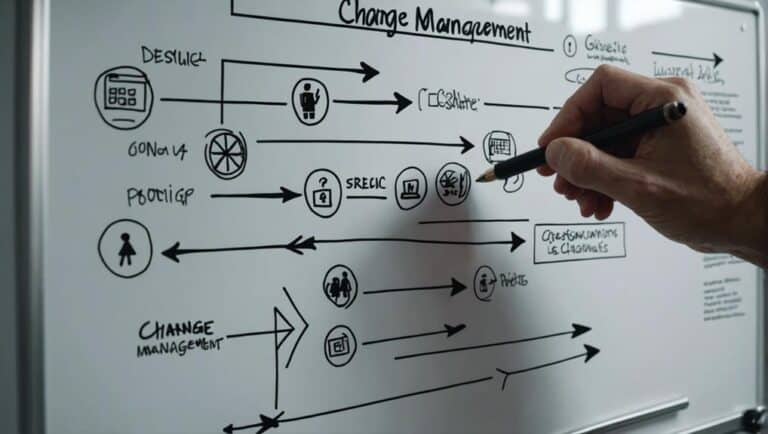Change is a difficult and complex process, but it’s crucial for businesses to stay relevant and adapt to the ever-evolving marketplace. As a change manager, it’s your responsibility to ensure that changes are made successfully and efficiently.
The goal of change management is to help organizations cope with change by improving their ability to adapt and adjust. There are many types of changes that can be managed, from product changes to organizational changes.
Change management can be accomplished through a number of different methods, including training employees on how best to handle the change and communicating with them about what they can expect as it happens.
Here are 10 tips to get you started:
1. Understand the Problem & Define the Change
Before a manager can successfully drive change within their company, they first need to take the time to understand the problem and define the change required.
This means understanding what needs to be changed, why it needs to be changed, and how it will benefit the company as a whole.
Some common causes are:
a) External factors: changes in technology, social norms, and laws
b) Internal factors: changes in needs, values, and desires
Change can be gradual or sudden , depending on the situation. It might also be necessary to make multiple changes at once.
2. Identify Stakeholders
When initiating change, it’s important to identify the right stakeholders and understand their needs. Depending on the type of change, these stakeholders may include individuals, departments or offices within an organization, as well as outside groups that may be affected by the change.
To help you identify the various stakeholders ask yourself the following questions:
- Who will be affected?
- Who will benefit?
- Who will oppose?
- Who will support?
Once you know who is involved and what they need from the process, you can start to build a plan that meets everyone’s needs.
3. Develop Goals
It’s important to have goals when planning out the change process. These goals should be specific, measurable, attainable, realistic and timely (SMART). They should also be aligned with the overall objectives of the organization.
Goal setting is a critical step in any successful management initiative. It helps individuals and organizations prioritize and plan for necessary changes, make sure those changes are consistent with company culture and goals, anticipate obstacles to implementation, monitor progress, and adapt as needed.
What do you hope to accomplish by implementing the change? What are the specific goals?
Here are a few tips to get started:
Determine your overall goal: Are you looking to improve employee satisfaction, reduce stress levels or achieve some other specific outcome? Once you know the goal, it’s easier to develop specific, measurable goals that will help you reach it.
Break the goal down into smaller, more achievable steps: If your goal is to increase employee satisfaction, setting short-term (but attainable) goals like ensuring that all employees have a say in decisions and receiving regular feedback may be more effective than trying to achieve a perfect workplace overnight.
Chart progress and ensure accountability: Having clear statistics on changes made and objectives achieved can also help keep everyone on track and motivate them along the way. Create a timeline for reaching your goals and make sure those working towards them are held accountable – whether through financial penalties or public recognition.
4. Determine Risks
Risk assessment is another key component. The risk of failure is always present when making major organizational changes.
To minimize this risk, you must determine which risks are acceptable and which ones require action.
The most common types of risks are:
Business risks: These occur when there is uncertainty about how a project will turn out. For example, if you’re planning to launch a new product, you’ll want to assess potential market acceptance, competition, customer response, etc.
Organizational risks: These are the risks associated with changing the structure or processes of an organization. Examples include creating new positions, merging two or more divisions, introducing new technology, or moving jobs overseas.
Political risks: These occur when people don’t agree with a decision or plan. They could involve conflicts over resources, conflicting opinions about the best approach to take, or even outright opposition to the idea itself.
How will the change impact the stakeholders? Will there be negative consequences? Are there risks associated with the change? If so, what are those risks?
5. Define Success Criteria
You shouldn’t start a change process without having an ideal outcome. Success criteria are the benchmarks against which you measure success during the process.
For example, if you’re evaluating a change that involves increasing communication between departments, you might use a metric such as “percentage of time spent communicating” or “number of meetings attended.”
Successful change management is a process that results in an organization achieving its goals while mitigating the risk of failure. It requires effective communication, coordination, and leadership skills to successfully navigate through multiple challenges.
What will determine whether the change was successful? Is the change expected to succeed? What will be measured to determine success?
6. Establish Milestones
Milestone tracking is one of the most important aspects of change management because it helps you gauge progress toward your goals.
You should establish milestones at each step of the process. A milestone is simply a point at which you expect to see significant progress.
For example, if you’re implementing a new system, you might set up a milestone where 50% of users are using the new system by the end of the first month. This would indicate that you’ve reached half of your overall goal.
7. Plan Communication
Perhaps the most vital component of all types of management, communication is also one of the most difficult skills to master. It’s not just about speaking and writing, but it also includes listening, reading and observing. Communication can be seen as a process that links people together, allowing them to share information.
Good communication skills are essential for any company, especially in today’s digital world where information travels at speeds faster than ever before. With the rise of social media and other channels, companies need to find new ways to effectively communicate with their customers or clients. They need to find new ways to keep up with all of these channels and how they are being used by their customers or clients.
Answer the following: how will the changes be communicated? Who will communicate the information? How often will communication take place?
Successful leaders understand how valuable a tool good communication is.
8. Prepare Employees
One of the most important aspects of successfully driving change is ensuring that your employees are on board. Without buy-in from staff, it will be very difficult to implement any new processes or procedures.
The moment they learn what is happening they will want to know will employees be trained? What training will they receive? How will they be compensated?
Managing resistance can be difficult, but it is important to remember that people are resistant for a reason.
The process can be disruptive and scary, so it is important to understand why people are resisting and what you can do to ease their fears.
Here are a few tips for getting employees on side:
- Have an open conversation with your team about the changes coming up and why they are happening. Be sure to listen to their concerns and answer any questions honestly.
- Help them see how the change will benefit them personally by showing how it will make their work easier or help them grow in their career.
- Share success stories of other companies or teams who have successfully gone through similar changes. This will help build confidence that the team can overcome any challenges along the way.
- Involve employees in planning and decision-making whenever possible and address any concerns or resistance upfront.
- Encourage open communication throughout the process.
It’s essential to manage expectations, this means communicating clearly what will happen during the transition period. Also, make sure that all parties understand the reasons behind the change.
See also: The Fear of Change: Why Is It So Hard For People And Companies To Accept Change?
9. Be flexible and agile
Change management isn’t a one size fits all process, so it’s important to be flexible and agile in your approach. Depending on the situation, you may need to adjust your plans or adapt your strategies.
Being open to change will help you be more successful in driving changes within your business. You must be able to adapt quickly to changing circumstances.
A common misconception among managers is that if they don’t plan ahead then everything will fall into place. In order to succeed, you must be able to adapt to changing circumstances. A rigid approach may result in unnecessary delays, which could cause problems further down the line.
10. Evaluate Results
Evaluation is an important step in change management. It allows you to determine how successful the change has been and what needs to be done to make it even more successful.
When evaluating the results of change management, it is important to consider both tangible and intangible outcomes.
Tangible outcomes can be measured by looking at changes that have been made, while intangible outcomes may not be as easily measurable but are just as important.
Some key intangible outcomes to consider when assessing change management include:
- The extent to which the organization has been able to achieve its objectives.
- How well it is performing against its strategic plan and how much it has achieved in terms of meeting its targets.
- Whether there are any gaps between what was planned and what has actually occurred.
- What lessons can be learned from this experience

How do you successfully drive business changes?
Leadership is all about change. It’s the ability to guide a group of people through difficult transitions and help them reach their goals. A good leader knows how to navigate change, inspire others and motivate them to achieve great things.
However, not everyone understands what it takes to create and sustain organizational change. In fact, many leaders have a vision that’s quite different from what’s required in reality. To be successful, they need to be flexible and open-minded, willing to experiment and learn as they go along.
The other key ingredient for success is an understanding of consumer expectations. These days, consumers expect companies to deliver better products faster and at a lower cost. If businesses want to keep up with the competition, they need to reorganize their work culture and find new ways of doing things.
Employees are often resistant, so it’s important that the leader sets the tone early on and gets them on board with the new way of working. If employees embrace changes, it will be much more fruitful for everyone involved. However, if they resist or don’t buy into the new system, then you are likely doomed for failure.
What are some common pitfalls to avoid when driving changes?
Change is inevitable, but that doesn’t mean it’s always easy. It’s important to be prepared for the challenges that come with change, and to know what pitfalls to avoid.
One common pitfall is introducing change too quickly. When changes are made all at once, it can be difficult for employees to adapt. It’s important to introduce change in stages, and avoid sudden impacts.
Another common pitfall is neglecting communication. When employees don’t understand why changes are being made or how they will affect them, they may become resistant or even hostile towards the changes. Good communication is key during times of change, so managers should make sure information is easy to access and understand.
It is also common to expect too much from employees too soon. Employees need time to adjust to new processes and practices, so expecting them to be up-to-speed right away can be unrealistic. Managers should give employees plenty of time to get used to the new way of doing things before expecting them to excel at it.
Finally, one of the most common mistakes is not planning ahead properly. Without a solid plan in place, changes can easily fall apart or fail altogether. It’s important to take the time to develop a detailed plan, and to make sure everyone involved is on board with it.
By avoiding these common pitfalls, you’ll be well on your way to successfully driving change in your organization!
What are some key principles of successful change management?
There are a few key principles of successful change management that can help your organization make the transition as smooth as possible.
First, it’s important to have a clear understanding of what needs to change and why.
Second, you need to have a plan for how the changes will be implemented. This includes setting realistic goals and timelines, and ensuring that everyone who needs to be involved is on board.
Third, you need to provide support throughout the transition process. This includes training for employees who will be using the new system, as well as communication plans, so everyone is kept in the loop.
Finally, it’s important to track progress and adjust course as necessary. No change management plan is ever perfect, so it’s important to be prepared for bumps in the road.
How can you ensure successful implementation of changes?
In order for a change management initiative to be successful, it’s important to have the support of leaders at all levels within an organization. Leaders need to be aware of the potential for scope creep and ensure that people are rewarded for extra effort and not penalized for going a little over budget. They also need to make sure that the project’s scope is properly updated as it gets under way.
Stakeholders need to be identified and actively engaged throughout the process of making a change initiative successful. Leaders should focus on delivering benefits that were initially approved for the project, rather than trying to do too much at once. And finally, leaders must be willing to admit when success has not been achieved and use meaningful metrics instead of traditional ones.
Leaders need to understand that resisting change is human nature. They need to recognize and overcome the resistance of people who don’t want to make changes in order to achieve success with their change management initiatives.
What are some strategies for successfully managing resistance to change?
When it comes to change management, one of the most important things to remember is that change will always meet some resistance. No matter how well you plan or how much people may want change to happen, there will always be those who are resistant for one reason or another. This is why it’s so important to have a strategy in place for managing this resistance.
There are many strategies you can use, but here are a few of the most effective ones:
- Early engagement is key – Bringing teams into the decision-making process early on will help ensure that they are more willing to accept and implement the changes later on.
- Diversity produces better results – A diverse company performs better than a less diverse one, so it’s important to make sure all voices are heard during the change process.
- Make everybody involved – The general rule is to make everyone feel included and have their input listened to. This helps reduce feelings of resentment and fosters a sense of ownership over the changes being made.
- Don’t mandate change from the top down – When people feel like they’re being forced to do something against their will, they’re more likely to resist it bitterly. Instead, let them come on board in their own way and at their own pace.
- Empower individuals – Empowering others not only grants them authority, but it also acknowledges the individuals and sets them up as change agents. This helps the team pivot when necessary and makes everyone feel like they’re a part of the process.
What are some techniques for effectively communicating changes?
There are two perspectives essential for change management: the individual perspective and the organizational perspective.
From an individual perspective, it is important to understand how changes will impact them and what they need to do to adapt.
From an organizational perspective, it is important to understand how changes will impact the company as a whole and what steps need to be taken to ensure a smooth transition.
It is also important to remember that communication is a two-way street. Both individuals and organizations need to be willing to listen and communicate openly in order to successfully manage changes.
How can you create a change-friendly environment?
In order for employees to feel comfortable with change, it is important to set the tone using goals and by identifying use cases.
When people can see how their work might be changing and how it will benefit them, they are more likely to get on board.

Leaders need to create a positive, contagious energy around change so that anxiety or negativity doesn’t take hold. A good way to do this is by managing the process of change in such a way that employees feel like they have some control over it. This also helps keep the pace up so that energy stays high.
It’s also important to build in reinforcement systems like a well-articulated timeline or change management guarantees success.
These measures help ensure that everyone understands what is happening and why, which makes the transition smoother for everyone involved.
What is the role of leadership in successful change management?
Leadership is a critical part of successful change management. In order to ensure that changes are successfully implemented, leaders need to be on board and understand the goals of the change initiative. They also need to be able to motivate employees and help them through the transition.
A study by Prosci found 93% of participants with excellent change management met or exceeded objectives, while only 15% of those with poor change management met or exceeded objectives.
This data shows that effective leadership is essential for successful change management. Leaders who are able to motivate their employees and get them on board with changes are more likely to see success than those who do not have this ability.
Are the 10 Tips for Change Management also applicable for Digital Transformation Initiatives?
Yes, the 10 tips for change management are indeed applicable for effective digital transformation strategies. It is essential to have a clear vision, strong leadership, and effective communication to ensure a smooth transition. Additionally, involving employees and addressing resistance are also crucial for successful digital transformation initiatives.
What are some lessons learned from successful change management initiatives?
Leaders in any organization can benefit from change management initiatives, but there are some key lessons that should be learned in order to ensure success.
First, it’s important to make sure that resources are allocated properly and that the scope of the project is considered.
Leaders must also take into account for change over time, so they can plan accordingly.
Additionally, change management often takes a new scope into account which needs champions and supporters from all sectors to help make the change happen. Stakeholders need to be engaged throughout the process, so they are supportive of the final product.
In addition, leaders need to be willing to use meaningful metrics with which the company can succeed even if they are not traditional metrics like on time, on budget and on spec.
Finally, resistance to change is human nature and leaders need to recognize that resistance is always present and work on overcoming it.
Sources





